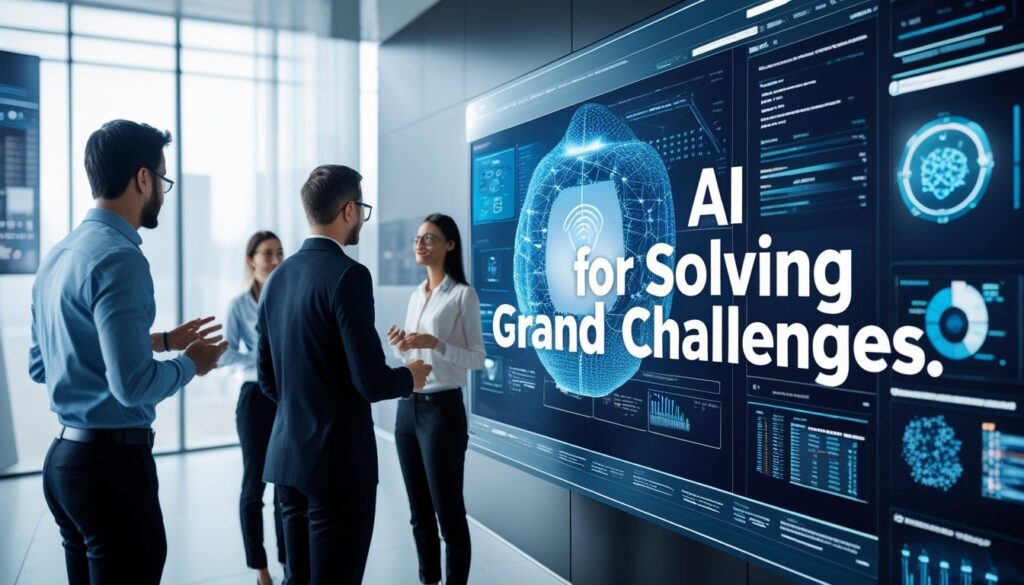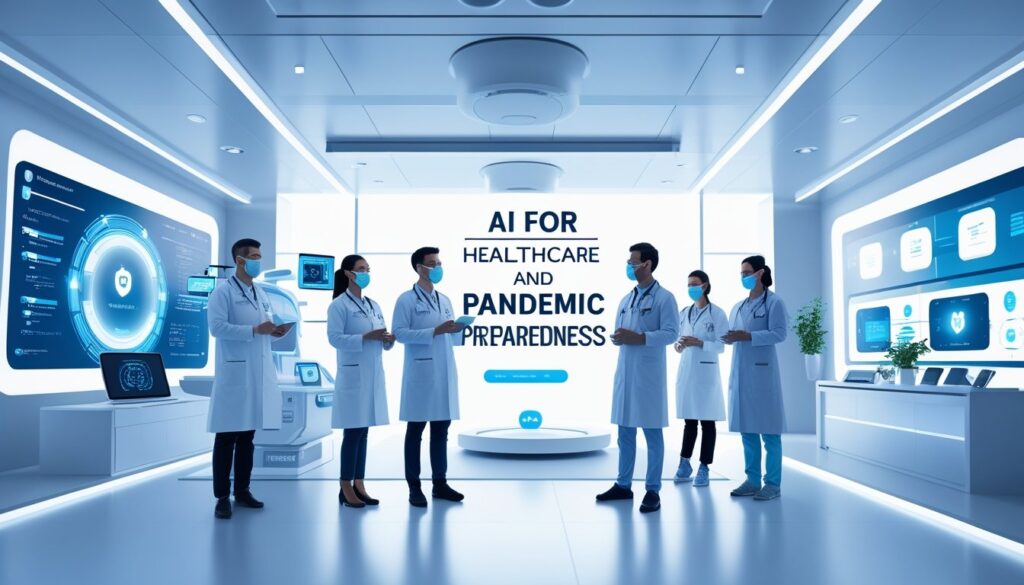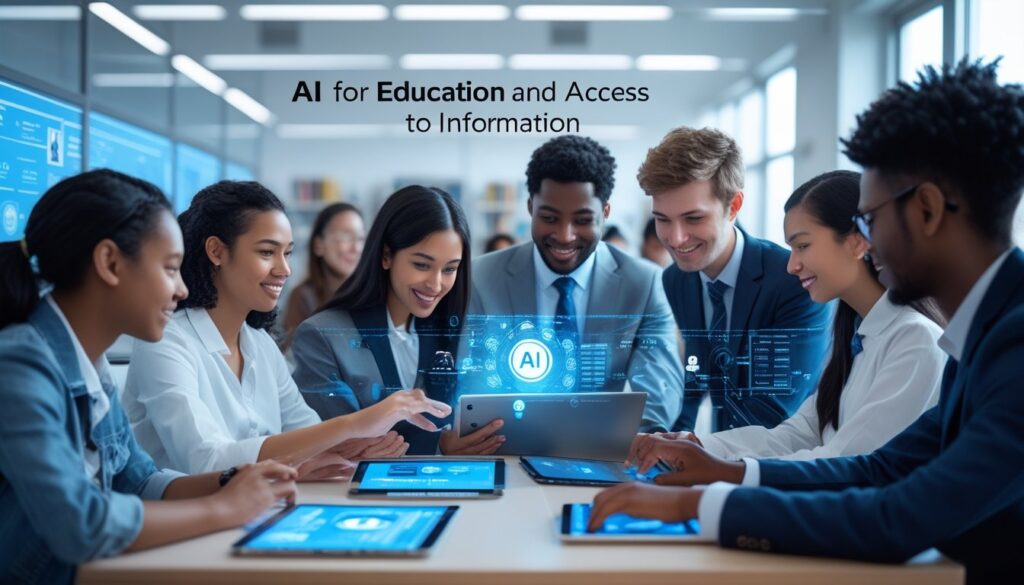Explore how AI for Solving Grand Challenges in climate change, healthcare, and poverty. This 7000-word guide details real-world applications, ethical considerations, and the future of global problem-solving with artificial intelligence.

The Confluence of Crisis and Cognition
Humanity stands at a unique crossroads in the 21st century. We are simultaneously facing a convergence of monumental, interconnected problems—the “Grand Challenges”—while developing the most powerful tool in our history to potentially solve them. Climate change threatens our ecosystems and food security. Pandemics and healthcare disparities affect billions. Economic inequality and educational gaps stifle human potential. These problems are complex, systemic, and often seem intractable to traditional, siloed approaches.AI for Solving Grand Challenges
Enter Artificial Intelligence. AI is not merely another technological advancement; it is a new form of cognitive capital. It is a scalable, accelerating capacity for pattern recognition, prediction, and optimization that can be applied across every field of human endeavor. The central thesis of our time is that AI for Solving Grand Challenges represents the most promising pathway to a sustainable, equitable, and prosperous future for all.
This 7,000-word article is a deep dive into this transformative potential. We will move beyond the hype to examine the concrete, real-world applications where AI is already making a difference. We will explore how machine learning models are forecasting climate disasters, how neural networks are discovering new drugs, and how algorithms are optimizing aid distribution. However, we will also confront the significant risks and ethical dilemmas inherent in wielding such a powerful tool. The journey of AI for Solving Grand Challenges is not a guaranteed success story; it is a race between deployment and peril, between wisdom and power. This is your guide to the front lines of that race.AI for Solving Grand Challenges
Part 1: Defining the Grand Challenges – The Problems AI Must Solve
Before we can understand the solution, we must clearly define the problems. “Grand Challenges” are not just large problems; they are specific, critical barriers that, if removed, would enable unprecedented human progress. They share common characteristics:
- Global Scale: They affect a significant portion of the world’s population, transcending national borders.
- Complex System Dynamics: They are not simple cause-and-effect problems but involve intricate feedback loops between environmental, social, economic, and technological systems.
- Resistance to Traditional Solutions: Standard linear approaches have failed to make sufficient progress.
- Profound Human Impact: Their resolution is essential for the long-term survival and flourishing of humanity.
For the purpose of this article, we will focus on four primary domains where AI for Solving Grand Challenges is most active:
- Climate Change and Environmental Sustainability
- Healthcare and Pandemic Preparedness
- Poverty, Economic Inequality, and Food Security
- Education and Access to Information
Part 2: AI for Climate Change and Environmental Sustainability
The climate crisis is a “wicked problem” par excellence, involving vast datasets, complex climate models, and interconnected systems. AI is becoming an indispensable tool for mitigation, adaptation, and resilience.AI for Solving Grand Challenges
2.1 Precision Forecasting and Climate Modeling
Traditional climate models run on supercomputers and are incredibly resource-intensive. AI augments and accelerates this process.AI for Solving Grand Challenges
- High-Resolution Weather and Disaster Prediction: Machine learning models can analyze historical weather data, satellite imagery, and real-time sensor data to predict extreme weather events—hurricanes, floods, wildfires—with greater accuracy and lead time. For example, Google’s AI has improved the accuracy of rainfall forecasting, and startups are using AI to predict wildfire paths, enabling better evacuation plans and resource allocation.
- Accelerating Climate Simulations: AI can be used to create “emulators” or “surrogate models” that approximate the results of complex physical models in a fraction of the time. This allows scientists to run thousands of scenarios to understand the probabilistic outcomes of different policy decisions or emission pathways.
2.2 The Clean Energy Transition
Decarbonizing our energy grid is a monumental task. AI is the key optimizer.AI for Solving Grand Challenges
- Smart Grid Management: The transition to renewables like solar and wind is complicated by their intermittent nature. AI algorithms can forecast energy supply (sunlight, wind) and demand (peak usage times) to dynamically balance the grid, integrate diverse energy sources, and prevent blackouts.
- Accelerated Materials Science: Discovering new materials for better batteries, solar panels, and carbon capture is slow and expensive. AI can predict the properties of hypothetical materials by analyzing vast databases of known compounds, drastically speeding up the R&D cycle. For instance, Microsoft’s Project Moab is using AI to discover new battery electrolytes that are less dependent on scarce lithium.
2.3 Environmental Monitoring and Conservation
- Precision Agriculture: AI-powered drones and satellites can monitor crop health, detect pests and diseases early, and optimize irrigation and fertilizer use. This increases yield while reducing water consumption and chemical runoff, a major source of environmental pollution.
- Biodiversity Protection: AI can process camera trap images and audio recordings to monitor wildlife populations, track endangered species, and detect poaching activity in real-time. The organization Rainforest Connection uses old cell phones and AI to listen for the sounds of illegal logging and alert authorities.AI for Solving Grand Challenges
2.4 Carbon Capture and Circular Economy
- Optimizing Carbon Capture Systems: AI can model and control direct air capture systems to make them more efficient and less energy-intensive.
- Waste Management: Computer vision systems can be installed in recycling facilities to identify and sort different types of waste with superhuman speed and accuracy, dramatically improving recycling rates and enabling a true circular economy.AI for Solving Grand Challenges
Part 3: AI for Healthcare and Pandemic Preparedness

The COVID-19 pandemic was a stark reminder of our global vulnerability. AI is being deployed to build a more resilient, proactive, and personalized healthcare system.AI for Solving Grand Challenges
3.1 Drug Discovery and Development
The traditional drug discovery pipeline takes over a decade and costs billions. AI is compressing this timeline.AI for Solving Grand Challenges
- Target Identification: AI can analyze genetic, proteomic, and clinical data to identify new biological targets for drugs.
- Generative Chemistry: Instead of just screening existing compounds, generative AI models can design novel drug-like molecules from scratch with specific desired properties. Companies like Exscientia and Insilico Medicine have used AI to design new drug candidates for various diseases in a matter of months, not years.
- Clinical Trial Optimization: AI can help design more efficient clinical trials by identifying suitable patient cohorts, predicting potential side effects, and monitoring trial data in real-time to adjust parameters.
3.2 Diagnostic Imaging and Early Detection
This is one of the most mature applications of AI for Solving Grand Challenges in healthcare.
- Radiology and Pathology: Deep learning algorithms can analyze X-rays, MRIs, and CT scans to detect diseases like cancer, tuberculosis, and strokes with accuracy rivaling or exceeding human experts. They can also flag subtle patterns that the human eye might miss, enabling earlier intervention.
- Retinal Scans: AI systems can diagnose diabetic retinopathy and other conditions from retinal images, making screening accessible in remote areas without a specialist.AI for Solving Grand Challenges
3.3 Pandemic Prediction and Response
- Early Warning Systems: AI can analyze non-traditional data sources—news reports, flight data, social media, and animal health data—to identify potential disease outbreaks before they become pandemics. BlueDot, a Canadian company, flagged the COVID-19 outbreak days before official WHO announcements.
- Genomic Sequencing and Variant Tracking: During a pandemic, AI can rapidly analyze the genomic sequences of a virus to track the emergence and spread of new variants, informing public health responses and vaccine updates.AI for Solving Grand Challenges
3.4 Personalized Medicine
The “one-size-fits-all” model of medicine is ending. AI can integrate a patient’s genetics, lifestyle, and medical history to recommend tailored prevention strategies and treatments, moving us toward an era of truly personalized care.AI for Solving Grand Challenges
Part 4: AI for Poverty, Economic Inequality, and Food Security
These challenges are deeply rooted in systemic inefficiencies and lack of access. AI can help bridge these gaps.AI for Solving Grand Challenges
4.1 Precision Agriculture for Food Security
As mentioned in the climate section, AI-driven precision agriculture is a direct tool for combating hunger. By optimizing yields and reducing crop loss for smallholder farmers—who produce a third of the world’s food—AI can have a massive impact on global food security.AI for Solving Grand Challenges
4.2 Financial Inclusion
Over 1.7 billion adults remain unbanked. AI is helping to bring them into the formal economy.AI for Solving Grand Challenges
- Alternative Credit Scoring: In regions with low banking penetration, AI can analyze non-traditional data (mobile phone usage patterns, utility bill payments, psychometric tests) to create credit scores for individuals who were previously “invisible” to the financial system. This allows them access to loans, insurance, and other financial services.
- Fraud Detection and Prevention: AI systems protect the financial assets of the world’s most vulnerable populations by detecting fraudulent transactions in real-time.
4.3 Humanitarian Aid and Disaster Response
When disaster strikes, getting aid to the right people at the right time is critical. AI can optimize this process.AI for Solving Grand Challenges
- Damage Assessment: Satellite and drone imagery analyzed by AI can quickly map the extent of damage after an earthquake or flood, directing rescue teams to the most affected areas.
- Supply Chain Logistics: AI can optimize the complex logistics of aid delivery, ensuring that food, medicine, and supplies reach those in need via the most efficient routes, minimizing waste and delay.
Part 5: AI for Education and Access to Information

Education is the foundation of human potential. AI has the power to democratize access to high-quality learning.
5.1 Personalized Learning
The factory model of education, where one teacher delivers the same lesson to 30 students, is outdated. AI-powered platforms can act as personal tutors for every student.
- Adaptive Learning Systems: These systems assess a student’s knowledge in real-time, identify gaps in understanding, and serve up customized lessons and exercises tailored to their specific learning pace and style. This ensures that no student is left behind and every student is sufficiently challenged.
- Automated Feedback: AI can provide instant, detailed feedback on student essays and coding assignments, freeing up teachers to focus on higher-level mentorship and support.
5.2 Breaking Down Language and Accessibility Barriers
- Real-Time Translation: AI-powered translation tools are breaking down language barriers, allowing people to access educational content and communicate in real-time regardless of their native language.
- Accessibility Tools: AI can generate automatic subtitles for videos, describe images for the visually impaired, and transcribe lectures for the hearing impaired, making information accessible to all.
Part 6: The Ethical Imperative – Navigating the Risks of AI for Good
The power of AI for Solving Grand Challenges is immense, but it is not a panacea. Its application is fraught with ethical pitfalls that must be navigated with care.
6.1 The Problem of Bias and Fairness
AI models are trained on data, and our data is often a reflection of historical and social biases. An AI used for credit scoring could perpetuate racial discrimination if trained on biased historical lending data. An AI used in healthcare could be less accurate for minority populations if trained predominantly on data from white patients. Vigilant auditing for bias and the use of diverse, representative datasets is non-negotiable.
6.2 The Privacy Paradox
Many AI solutions, especially in public health and finance, require vast amounts of personal data. This creates a tension between utility and privacy. Robust data governance frameworks, anonymization techniques, and systems that allow for “federated learning” (where the AI learns from data without it ever leaving the user’s device) are essential to build trust.
6.3 The Governance Gap and Concentration of Power
The development of powerful AI is currently concentrated in a handful of large tech corporations and wealthy nations. There is a real risk that the benefits of AI for Solving Grand Challenges will not be distributed equitably, potentially exacerbating the very global divides it seeks to bridge. We need inclusive global governance models that ensure this technology serves all of humanity, not just the privileged few.
6.4 Environmental Cost of AI
Training large AI models consumes significant energy, contributing to the carbon footprint. The AI community must prioritize the development of more energy-efficient algorithms and run compute centers on renewable energy to ensure that the solution does not worsen the problem.
Part 7: The Path Forward – A Call for Collaborative Intelligence
The successful application of AI for Solving Grand Challenges will not be achieved by algorithms alone. It requires a new model of collaboration.
- Public-Private Partnerships: Governments, academic institutions, and private companies must collaborate to share data, expertise, and resources. Grand challenges cannot be solved by siloed entities.
- AI for Social Good Initiatives: A growing movement within tech is dedicated to applying AI expertise to humanitarian and environmental problems. Supporting and scaling these initiatives is crucial.
- Capacity Building in the Global South: To avoid a new form of technological colonialism, we must invest in building AI capacity, infrastructure, and talent in developing nations, ensuring they can use these tools to solve their own most pressing challenges.
- Centering Human Values: Ultimately, AI is a tool. Its purpose and goals must be set by humans, guided by a shared ethical compass. The focus must always remain on human dignity, equity, and planetary health.
The Choice of a Generation

The grand challenges we face are a test of our species’ maturity. They demand that we evolve from a competitive, short-sighted species to a collaborative, wise one. Artificial intelligence is the mirror and the amplifier of this choice. In its algorithms, we see reflected our own biases and shortcomings. In its potential, we see the blueprint for our transcendence.
The narrative of AI for Solving Grand Challenges is still being written. It can be a story of unprecedented human progress, where we eradicate disease, stabilize our climate, and unlock every child’s potential. Or, it can be a story of missed opportunity and amplified inequality. The outcome depends not on the technology itself, but on us—on our wisdom, our empathy, and our courage to build a future where technology serves humanity’s deepest needs and highest aspirations. The tool is ready. The question is, are we?

